Table of Contents
As budgets tighten and operational scrutiny intensifies, SaaS spending has become one of the most unpredictable—and fastest-growing—line items for finance and procurement teams. The convenience and scalability that once made SaaS an easy win now introduce challenges around visibility, cost control, and security. For many organizations, the real risk isn’t just paying more—it’s paying blindly.
That’s why a SaaS spend management platform is no longer a nice-to-have. It’s a core capability for controlling software costs, avoiding redundancy, and aligning spend with strategy. This article explores the growing urgency behind SaaS cost optimization—and how the right platform helps you regain control, uncover savings, and reduce risk across your entire software ecosystem.
More SaaS, Greater Spend
SaaS portfolios continue to expand, and with that growth comes rising complexity, financial risk, and operational burden. Today, organizations manage an average of 275 SaaS applications—and that number keeps climbing. The average cost per employee has surged to $4,830 annually, marking a 21.9% increase from the previous year. These numbers aren’t just benchmarks; they’re red flags for procurement and finance leaders under pressure to rein in costs.
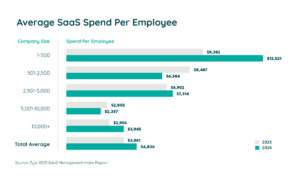
What’s fueling this acceleration? Two major trends: the rapid adoption of AI-native tools and a shift toward consumption-based pricing models. These newer pricing structures are harder to predict and even harder to control. As more teams purchase software independently—often bypassing IT or procurement—visibility disappears and spending becomes decentralized.
Zylo co-founder Ben Pippenger captured the issue clearly during SaaSMe 2025: “Every app has its own flavor of what they’re charging for—and AI is accelerating that into new pricing models we haven’t seen before.”
“Every app has its own flavor of what they’re charging for—and AI is accelerating that into new pricing models we haven’t seen before.”
— Ben Pippenger, Co-founder at Zylo
If this growth goes unmanaged, the consequences escalate quickly. Organizations risk more than overspending—they risk operational inefficiencies, overlapping tools, compliance gaps, and increased exposure to shadow IT. When companies fail to take control, they end up paying for apps they don’t need, licenses they don’t use, and renewals they didn’t plan for.
Gartner projects that global SaaS spend will reach $299 billion in 2025—a 19.2% increase from the previous year. More critically, Gartner warns that by 2027, organizations without centralized visibility into their SaaS environments will overspend by at least 25% and face five times the cybersecurity risk.

The takeaway is clear: this isn’t a future issue—it’s already happening. Companies that take steps now to implement SaaS spend management will be far better positioned to optimize spend, reduce exposure, and scale their software investments with confidence.
6 Ways a SaaS Spend Management Platform Saves You Money
SaaS costs rarely decline on their own. Without intentional oversight, your software stack can quietly absorb budget, create redundancies, and trigger waste—before anyone notices. That’s why finance and procurement teams are turning to SaaS spend management platforms like Zylo. These platforms don’t just track spending—they help you actively reduce it.
Here are six proven ways a SaaS spend management platform drives real savings across your software portfolio.
#1: Holistic Visibility into Software Spending
One of the most effective paths to SaaS cost optimization starts with visibility. When departments buy software independently, spending becomes fragmented. Misclassified expenses, buried subscriptions, and siloed contract data make it difficult—if not impossible—to understand your actual SaaS investment.
Gaining true visibility means consolidating this scattered data into a single, real-time view. By pulling from expense systems, accounts payable, and SSO integrations, platforms like Zylo give finance teams a complete picture of their software footprint. With that clarity, you can identify spend trends, enforce procurement policies, and eliminate unused or duplicate tools.
#2: Identifying Cost-Saving Opportunities
Once visibility is in place, the next step is optimization. Many organizations pay above-market rates for tools they barely use—or buy multiple apps with overlapping functionality. Without real usage data, these inefficiencies go unnoticed.
A SaaS spend management platform highlights exactly where to cut waste. It compares license provisioning to actual usage, flags reclaimable seats, and uncovers tools that perform the same job. It also benchmarks pricing to reveal opportunities for renegotiation. These insights turn guesswork into strategic, data-backed decisions—and that leads to direct SaaS cost savings.
#3: Real-Time Alerts for Unplanned Spend
Surprise software purchases are a quiet budget killer. Whether bought with a corporate card or buried in an expense report, unauthorized apps introduce redundancy, compliance concerns, and unplanned renewals.
The right SaaS spend management platform will issue real-time alerts the moment new software spend is detected—across credit card charges, purchase orders, or employee reimbursements. These alerts empower finance and procurement teams to step in immediately, check for overlap, and confirm whether the new tool aligns with policy or existing functionality. That kind of proactive oversight is key to stopping waste before it takes root.
#4: Smarter Purchase Order Management
Manual purchase order (PO) tracking often leads to missed renewal windows, contract mismatches, or duplicated purchases. It’s inefficient, prone to error, and slows down review processes.
You need PO data linked directly with usage metrics and contract records. Integrating PO data with your SaaS spend management platform allows teams to validate purchases in real time, confirm alignment with actual needs, and act on renewal terms ahead of deadlines. With real-time oversight, finance leaders gain better control over committed spend—and reduce the risk of surprises.
#5: Forecasting and Budgeting with Confidence
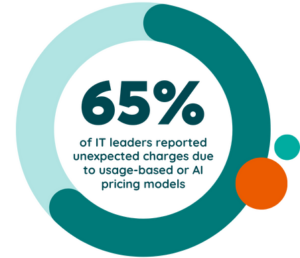 Forecasting SaaS costs is no longer as simple as counting seats. With the rise of AI-driven and usage-based pricing models, spend is more variable—and harder to predict. Many teams are caught off guard by usage spikes, overages, or scaling fees they didn’t anticipate. In fact, 65% of the IT leaders we surveyed reported unexpected charges on SaaS due to consumption-based or AI pricing models.
Forecasting SaaS costs is no longer as simple as counting seats. With the rise of AI-driven and usage-based pricing models, spend is more variable—and harder to predict. Many teams are caught off guard by usage spikes, overages, or scaling fees they didn’t anticipate. In fact, 65% of the IT leaders we surveyed reported unexpected charges on SaaS due to consumption-based or AI pricing models.
You need a SaaS spend management platform that helps finance leaders stay ahead of these changes. By modeling future spend based on usage trends, contract structures, and renewal timing, teams can shift from reactive budgeting to proactive planning. That translates to fewer surprises and more confident decision-making.
#6: Cost Allocation by Team or Department
Without transparency at the department level, it’s easy for software waste to spread unnoticed. When SaaS budgets are not centralized, teams often don’t realize what they’re spending—or what they’re duplicating.
A SaaS spend management platform brings spending into focus across every business unit, cost center, or region. Showback and chargeback reporting makes it clear who’s using what—and how much it’s costing. This level of visibility encourages smarter software choices, drives accountability, and helps departments manage their own spend more responsibly.
Guide to Managing SaaS Costs
Learn MoreKey Features of a SaaS Spend Management Platform
A SaaS spend management platform offers more than visibility. It delivers the control and insights needed to reduce software waste, improve forecasting, and drive measurable SaaS cost savings. Below are the essential features that power SaaS spend optimization at scale.
Always-On Discovery and Visibility
Without full visibility, it’s impossible to optimize spend. Zylo’s AI-powered discovery engine continuously scans your environment—pulling in data from financial systems, SSO tools, and direct integrations. It automatically identifies every application in use, along with the associated spend, contracts, and potential risks. This creates a living system of record that gives teams real-time awareness and the confidence to manage SaaS spend proactively.
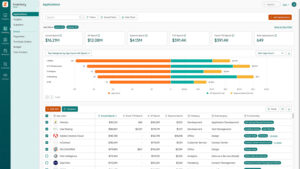
Real-Time Alerts for New Purchases
When new software enters the environment unnoticed, costs—and risks—rise fast. Zylo provides real-time alerts across credit card charges, expense reports, and procurement systems, flagging purchases the moment they occur. With this visibility, finance and procurement can step in early to assess overlap, check compliance, and keep unauthorized spend in check.
“Zylo allows for a singular interface to pull in all of our spend data for software. I can get notifications when new software is expensed, which allows me to keep a tight grip on software spend.”
Budget Tracking
Forecasting isn’t effective without real-time data. Zylo tracks SaaS spend against application-level budgets to provide immediate insight into how each tool is performing relative to expectations. This allows teams to spot overruns early, make in-flight adjustments, and align budgets more accurately with actual usage.

Purchase Order Management
Managing purchase orders manually creates friction and risk. Zylo brings PO data into direct alignment with usage trends and contract terms, offering end-to-end oversight of committed spend. This integration allows teams to validate purchases, confirm policy compliance, and act before renewal deadlines—leading to fewer surprises and stronger financial control.
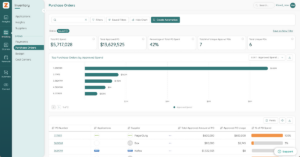
Cost Allocation
To encourage accountability, departments need to see their own impact on the bottom line. Zylo enables detailed showback and chargeback reporting, so every team can view its share of software costs. This visibility motivates smarter decisions, reduces duplication, and fosters cost-conscious behavior across business units.
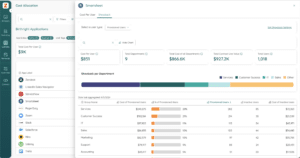
License Utilization Tracking
Unused licenses are one of the most preventable forms of waste. Zylo continuously monitors license utilization, identifying subscriptions that are inactive or underused. With this data, teams can reassign or retire licenses confidently—capturing fast, low-effort SaaS cost savings.
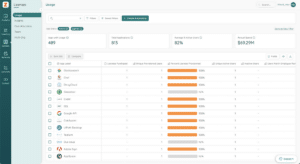
Automated Insights for Savings Opportunities
Manual audits miss too much. Zylo automates the analysis of license usage, contract terms, and pricing benchmarks to uncover opportunities for optimization. Whether it’s retiring redundant tools or renegotiating overpriced contracts, these insights lead directly to smarter software investments and reduced waste.

Track Cost Savings and Avoidance
SaaS cost optimization isn’t just about actions—it’s about outcomes. Zylo’s Savings Center tracks every dollar saved or avoided through initiatives like license reclamation and vendor consolidation. It’s a centralized hub that helps teams quantify their impact, share results, and demonstrate the ROI of SaaS spend management.

“With Zylo’s Savings Center, I can easily track all of our savings and cost avoidance data. Its seamless consolidation ensures everyone in our company has access to the same information, enabling us to transparently demonstrate the immense value that procurement contributes to our organization.”
– Lance Le, Sr. Strategic Sourcing Manager at Redis
Contract Management
Scattered contract data leads to missed deadlines and weak negotiation leverage. Zylo centralizes all vendor and contract information, linking it to usage and spend data in one place. This allows stakeholders to prepare for renewals strategically and ensures terms are reviewed—not just accepted.
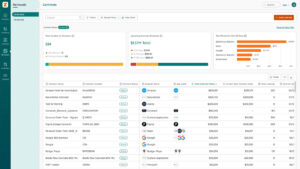
Renewal Calendar
Auto-renewals are easy to miss and expensive to fix. Zylo’s renewal calendar puts every upcoming contract event in one centralized view. With plenty of lead time, teams can evaluate value, prepare for negotiation, and decide whether to renew, consolidate, or cancel—preventing lock-in and driving better outcomes.
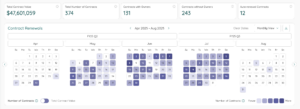
Ready to Save on SaaS? Zylo Can Help
Zylo helps you take back control of your software spend. By providing real-time visibility into every SaaS application in your environment, the platform makes it easy to reduce license waste, uncover shadow IT, and avoid unnecessary renewals. You’ll gain the insights needed to forecast more accurately, reallocate costs across teams, and negotiate better outcomes with vendors—all while keeping your SaaS stack lean and efficient.
With SaaS spending rising faster than most teams can track, now is the time to act. Zylo is built specifically for procurement and finance leaders who need more than just monitoring—they need results. Get a demo to see how Zylo helps you cut costs, mitigate risk, and unlock real SaaS cost savings across the business.
FAQs about SaaS Spend Management Platforms
What is a SaaS spend management platform?
A SaaS spend management platform gives organizations full control over their software investments. It tracks subscriptions, monitors usage, identifies waste, and highlights cost-saving opportunities—all in one system. The result is clear visibility and smarter software spend decisions.
Why is SaaS spend management important for businesses?
Without proper oversight, companies quickly overspend on unused or redundant tools. SaaS spend management helps align software investments with actual needs, leading to stronger budgets, reduced waste, and more efficient operations.
How does a SaaS spend management platform identify unused or underutilized software?
By analyzing real-time usage data, the platform detects licenses that aren’t being used or apps that see minimal engagement. These insights allow teams to reassign, reduce, or retire software and avoid unnecessary renewals.
Can a SaaS spend management platform help with compliance and security?
Yes. These platforms provide a centralized view of all software in use, helping you enforce policies, reduce shadow IT, and ensure only approved, secure applications are active in your environment.
How does a SaaS spend management platform assist in budgeting and forecasting?
With detailed spend history and usage trends, finance teams can forecast more accurately. These insights make it easier to plan for renewals, anticipate scaling needs, and set realistic SaaS budgets.
What challenges do companies face without a SaaS spend management platform?
Without centralized management, software spend becomes fragmented. Teams may purchase redundant tools, miss renewal dates, or continue paying for unused licenses—leading to wasted budget and greater security risk.
How does a SaaS spend management platform integrate with existing systems?
Most platforms connect with financial tools, SSO providers, and IT management systems. This enables seamless data collection and ensures you get a complete picture of your SaaS environment with minimal manual work.
Is a SaaS spend management platform suitable for small businesses?
Absolutely. Smaller organizations may not have sprawling software stacks, but they still need visibility and control. A SaaS spend management platform helps small teams manage software costs, avoid bloat, and scale more efficiently.
What features should I look for in a SaaS spend management platform?
Look for tools that deliver real-time visibility into SaaS applications, along with license tracking, automated alerts, contract and renewal management, budgeting tools, and security monitoring. Platforms like Zylo offer all of these features, designed to support both SaaS cost optimization and long-term value.


 — Ben Pippenger, Co-founder at Zylo
— Ben Pippenger, Co-founder at Zylo